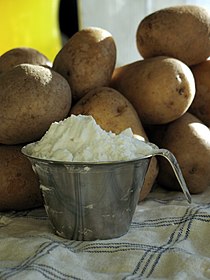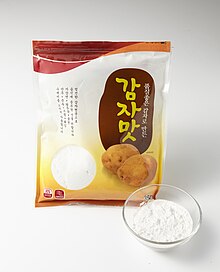Potato starch

Potato starch is starch extracted from potatoes. The cells of the root tubers of the potato plant contain leucoplasts (starch grains). To extract the starch, the potatoes are crushed, and the starch grains are released from the destroyed cells. The starch is then left to settle out of solution or separated by hydrocyclones, then dried to powder.
Potato starch contains typical large oval spherical granules ranging in size from 5 to 100 μm. Potato starch is a refined starch, containing minimal protein or fat. This gives the powder a clear white colour, and the cooked starch typical characteristics of neutral taste, good clarity, high binding strength, long texture, and minimal tendency to foaming or yellowing of the solution.
Potato starch contains approximately 800
These properties are used in food and technical applications.[2]
Use

Other examples are
Potato starch was also used in one of the earlier color photography processes, the
Potato varieties
The cultivation of potatoes for starch mainly takes place in Germany, the Netherlands, China, Japan,[6] France, Denmark, and Poland, but also in Sweden, Finland, Austria, the Czech Republic, Ukraine, Canada, and India.[citation needed]
Some potato starch is also produced as a
Identification

Examined under a microscope using a mixture of equal volumes of glycerol and distilled water, potato starch presents transparent, colorless granules, either irregularly shaped, ovoid or pear-shaped, usually 30 μm to 100 μm in size but occasionally exceeding 100 μm, or rounded, 10 μm to 35 μm in size. Starch granules exhibit characteristic dark crosses in polarized light. If potato starch is wetted it becomes sticky.[citation needed]
See also
References
- Agric. Biol. Chem. 47 (11): 2421–25. Archivedfrom the original on 2018-10-03. Retrieved 2013-03-19.
- ISBN 978-0-12-746275-2. Archivedfrom the original on 2022-02-01. Retrieved 2020-11-07.
- ISBN 978-0-470-06780-2. Archivedfrom the original on 2022-02-01. Retrieved 2016-01-10.
- ISBN 978-0-8138-2570-0. Archivedfrom the original on 2022-02-01. Retrieved 2020-11-07.
- ISBN 1-55832-176-4. Archivedfrom the original on 2022-03-21. Retrieved 2022-04-09.
- ^ In Japan, potato starch is called katakuriko (from katakuri "Erythronium japonicum", and ko "powder"), which refers to the starch from the Erythronium japonicum bulb. Because of its small quantity and high price, starch from E. japonicum is no longer common; potato starch has almost taken its place nowadays and only the name remains.
- from the original on 2022-04-09. Retrieved 2022-03-27.
